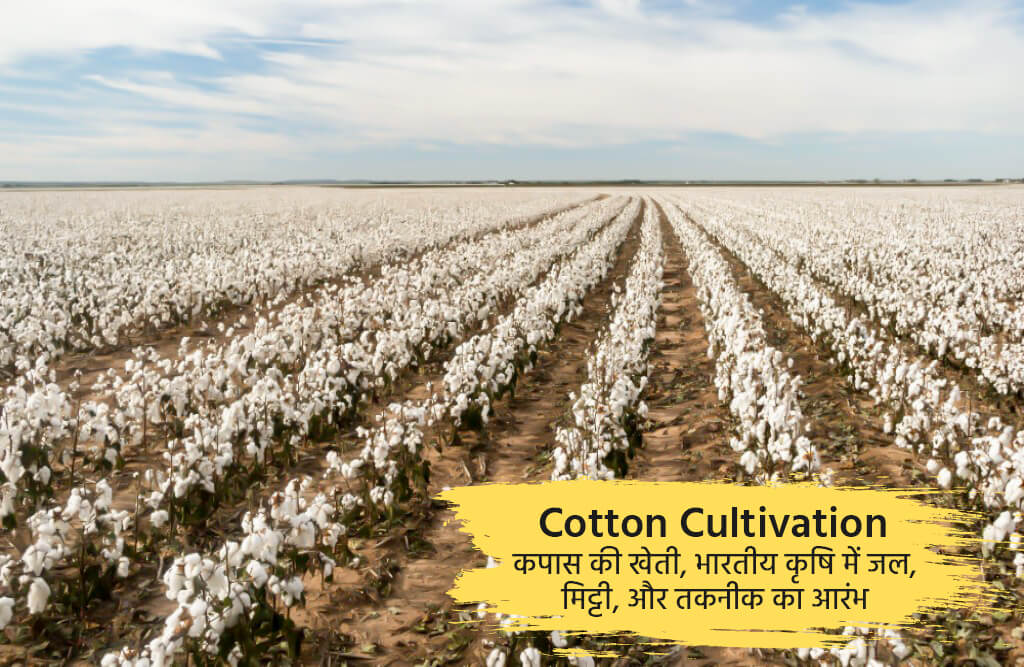
Cotton is one of India's most crucial cash crops, playing a significant role in the country's industrial and agricultural economy. It provides the fundamental raw material (cotton fiber) to the textile industry. Cotton cultivation in India supports livelihoods for around 6 million farmers and provides employment to approximately 40-50 million people in cotton trade and processing. In India, major cotton-producing states are divided into three regions: Northern region includes Punjab, Haryana, and Rajasthan; Central region includes Madhya Pradesh, Maharashtra, and Gujarat; Southern region includes Andhra Pradesh, Telangana, Karnataka, and Tamil Nadu. Despite the increasing demand for fiber, cotton cultivation still faces challenges due to excessive water and pesticide usage, making it less sustainable. The global industry finds itself in a crisis as traditional cotton farming practices are not consistently technologically advanced. To address this, there is a need to move towards adopting sustainable and dynamic sources, including organic farming methods.
Cotton thrives in warm climates, and major cotton-producing countries include India, China, Uzbekistan, and the United States. The success of cotton cultivation in Indian agriculture depends significantly on weather conditions and soil quality. Let's explore the most suitable conditions for cotton cultivation.
Cotton requires a minimum temperature of 15°C for germination, with an optimal temperature range of 21-27°C for vegetative growth. It can tolerate temperatures up to 43°C, but temperatures below 21°C are detrimental to plant growth. Cotton cultivation requires a warm and humid climate. The crop performs well in regions with extended periods of frost-free conditions along with higher temperatures and ample sunlight. Based on climate and the duration of the cultivation period, cotton needs 700-1,200 mm of water. While flood irrigation is common for cotton, alternate methods like furrow or drip irrigation are more efficient and water-conserving. Drip irrigation is gaining popularity, especially in central and southern regions with hybrid cotton varieties. Cotton cultivation necessitates soil moisture levels of 50-70%.
Cotton can grow in various soil types as long as the soil is well-drained and rich in organic matter. Sandy loam with good quantities of clay and organic matter, along with moderate levels of nitrogen and phosphorus, is generally suitable for cotton.
Before starting the cotton cultivation season, soil preparation is crucial. Remove any existing weeds and growing grasses. Subsequently, plow or till the soil deeply to break up any clumps and improve aeration. Ensure that the soil temperature is around 6 inches. Once the temperature stabilizes at this level, the soil is considered ready for sowing cotton. Adding some compost or aged manure to the soil enhances its structure, health, and fertility. Cotton is cultivated in various soil types, from deep loamy soils in the north to different depths of black clayey soils in the central region and dark and mixed black and red soils in the southern region.
To increase yield and ensure the quality of fibers, providing adequate support to growing plants is crucial. Balancing consistent crop care amid the crop's requirements, resource proficiency, and environmental conservation is highly essential. In periods of hot and dry weather, plants require more water. The most significant water demand for the crop is during the flowering season. Cotton plants grow slowly, making them vulnerable to pests in the early stages. Conversely, the leaves of the crop provide shade in later stages, reducing evaporation. Cotton seeds are planted using either ridge planting or seedbed sowing, depending on the region. For effective and water-efficient irrigation, mechanized methods like flood or alternate furrow irrigation are employed.
Cotton is considered ready for harvesting when its bolls open, typically occurring in mid-season. The success of the crop's harvest season depends on dry weather. Machines are used to remove the cotton from the open bolls, usually found in the spindle area. Strippers are an additional mechanical harvesting option, using rollers and brushes to strip the cotton from the branches, depositing it onto a conveyor. Both methods use air to convey the cotton into a basket, which is later emptied into a bale bag.
Environmental Impact of Cotton Cultivation: Cotton fields in general have been subjected to conventional agricultural practices over the past 70 years, resulting in a negative impact on the climate due to monoculture and the extensive use of pesticides and fertilizers. Emergency releases of large quantities of pesticides and fertilizers used in cotton fields contaminate water sources and contribute to pollution in the surrounding environment. Nitrous oxide, released from regular fertilizer use, is 310 times more potent than carbon dioxide and contributes to global warming.
Conclusion: sustainable and environmentally friendly practices are crucial for the future of cotton cultivation. Adopting organic farming methods and reducing the reliance on synthetic herbicides and pesticides will not only benefit the environment but also contribute to the long-term success of the cotton industry.